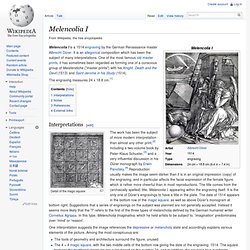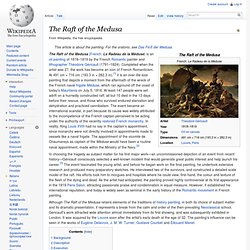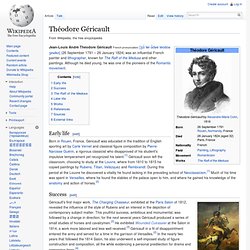

Melencholia I. Albrecht Dürer. Dürer's introduction of classical motifs into Northern art, through his knowledge of Italian artists and German humanists, has secured his reputation as one of the most important figures of the Northern Renaissance.

This is reinforced by his theoretical treatises, which involve principles of mathematics, perspective and ideal proportions. Early life (1471–90)[edit] Dürer's godfather was Anton Koberger, who left goldsmithing to become a printer and publisher in the year of Dürer's birth and quickly became the most successful publisher in Germany, eventually owning twenty-four printing-presses and having many offices in Germany and abroad. Koberger's most famous publication was the Nuremberg Chronicle, published in 1493 in German and Latin editions.
It contained an unprecedented 1,809 woodcut illustrations (albeit with many repeated uses of the same block) by the Wolgemut workshop. Wanderjahre and marriage (1490–94)[edit] First journey to Italy (1494–95)[edit] Self-portrait, 1508. Melencolia I. The engraving measures 24 x 18.8 cm.[1] Interpretations[edit] Detail of the magic square The work has been the subject of more modern interpretation than almost any other print,[2] including a two-volume book by Peter-Klaus Schuster,[3] and a very influential discussion in his Dürer monograph by Erwin Panofsky.[4] Reproduction usually makes the image seem darker than it is in an original impression (copy) of the engraving, and in particular affects the facial expression of the female figure, which is rather more cheerful than in most reproductions.

The title comes from the (archaically spelled) title, Melencolia I, appearing within the engraving itself. It is the only one of Dürer's engravings to have a title in the plate. One interpretation suggests the image references the depressive or melancholy state and accordingly explains various elements of the picture. An autobiographical interpretation of Melencolia I has been suggested by several historians. Notes[edit] References[edit] Le Radeau de la Méduse. The Raft of the Medusa. Although The Raft of the Medusa retains elements of the traditions of history painting, in both its choice of subject matter and its dramatic presentation, it represents a break from the calm and order of the then-prevailing Neoclassical school.

Géricault's work attracted wide attention almost immediately from its first showing, and was subsequently exhibited in London. It was acquired by the Louvre soon after the artist's early death at the age of 32. The painting's influence can be seen in the works of Eugène Delacroix, J. M. W. Background[edit] Plan of The Raft of the Medusa at the moment of its crew's rescue[4] In an effort to make good time, the Méduse overtook the other ships, but due to poor navigation it drifted 100 miles (161 km) off course. According to critic Jonathan Miles, the raft carried the survivors "to the frontiers of human experience. Description[edit] Detail from the lower left corner of the canvas showing two dying figures Execution[edit] Final work[edit]
Théodore Géricault. Jean-Louis André Théodore Géricault French pronunciation: [ʒɑ̃ lwi ɑ̃dʁe teodoʁ ʒeʁiko] (26 September 1791 – 26 January 1824) was an influential French painter and lithographer, known for The Raft of the Medusa and other paintings.

Although he died young, he was one of the pioneers of the Romantic movement. Early life[edit] Success[edit] Géricault's first major work, The Charging Chasseur, exhibited at the Paris Salon of 1812, revealed the influence of the style of Rubens and an interest in the depiction of contemporary subject matter. A trip to Florence, Rome, and Naples (1816–17), prompted in part by the desire to flee from a romantic entanglement with his aunt,[5] ignited a fascination with Michelangelo.
The Raft of the Medusa[edit] The painting ignited political controversy when first exhibited at the Paris Salon of 1819; it then traveled to England in 1820, accompanied by Géricault himself, where it received much praise. Later life[edit] Works[edit]